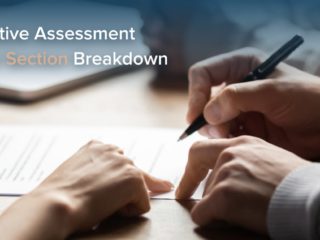|
Getting your Trinity Audio player ready...
|
If you’re considering taking the Executive Assessment (EA) to apply to an EMBA or full-time MBA program, you’re likely wondering what a good EA score is. In this article, I’ll discuss a few different things to consider to determine what a good EA score is for you.
- How the Executive Assessment Is Scored
- Using Percentiles to Determine What a Good EA Score Is
- What Most Business Schools Say Is a Good EA Score
- When a Good EA Score Is Higher Than 150
- Good Executive Assessment Section Scores
- The Moral of the Story
Let’s begin by discussing the basics of EA scoring.
How the Executive Assessment Is Scored
There are two stories of how the EA is scored. One is the official story on the website of the Graduate Management Admission Council (GMAC), the maker of the EA and the GMAT, and the other is the reality. Both the official story and the reality are that the EA has three sections, the Integrated Reasoning section, the Verbal Reasoning section, and the Quantitative Reasoning section. Additionally, both stories tell you that you get four scores when you take the EA, one score for each of the three sections and a total score.
However, when it comes to the actual numbers involved, the official story and the reality differ. The official story is that the three EA section scores range from 0 to 20 and that EA total scores range from 100 to 200. The reality is that each of the three EA section scores ranges from 2 to 18. Then, the EA total score is calculated by adding 120 to the three EA section scores. Accordingly, the minimum EA score is 120 + (3 x 2) = 126, and the maximum EA score is 120 + (3 x 18) = 174. So, you can score anywhere from 126 to 174 on the EA, and the midpoint score is 150.
KEY FACT:
You can score anywhere from 126 to 174 on the EA, and the midpoint score is 150.
I’m not sure why the official story differs from reality. It may be that GMAC left some room to expand the score range if necessary. In any case, now you know the basics of how the Executive Assessment is scored. So, let’s move on to discussing what constitutes a good EA score, first by considering EA score percentiles.
Using Percentiles to Determine What a Good EA Score Is
One way to determine what constitutes a good score on the Executive Assessment is to use score percentiles to determine what EA score is higher than average. After all, presumably, a score that is higher than average is a good score.
Unlike for the GMAT and GRE, for the EA, not much score data has been made available by the test-maker or schools. However, during a presentation, GMAC released the following EA score percentiles based on on the test scores of people who took the Executive Assessment between January 1, 2017 and September 15, 2019:
- 75th percentile: a total score of 153
- 50th percentile: a total score of 150
- 25th percentile: a total score of 146
There are a couple key things we can glean by considering these percentiles. One is that the middle score (50th percentile) is 150. So, at least for the time period from which we have data, 150 is an average EA score, and any score above 150 is an above average EA score.
Another thing that’s interesting is how closely clustered the scores are. Notice that the difference between the 50th percentile score of 150 and the 75th percentile score of 153 is only three points. So, scoring just three points above average could mean that you scored higher than 75 percent of all EA test-takers.
Since this data is from a few years ago, the percentiles could have shifted some. Still, we’ve seen at least what constituted an average for a year or two of the handful of years that the EA has been in existence.
TTP PRO TIP:
Pro Tip: By using score percentiles, you can get a sense of what would be considered a good EA score.
OK, now that we’ve gotten a sense of how test-takers have performed on the EA, let’s consider another way of determining what constitutes a good EA score: looking at what business schools have to say.
What Most Business Schools Say Is a Good EA Score
To understand where business schools stand on what a good Executive Assessment score is, we first have to understand a key thing about the EA. Unlike the GMAT or GRE, which business schools use for determining which applicants are the most qualified, the EA is considered a readiness test. In other words, rather than use the test for comparing candidates, schools use the EA largely for determining simply whether a candidate is ready to handle their program. So, for the most part, what constitutes a good EA score for a particular school is a score that is at or above the threshold score that indicates that a candidate is ready to handle that school’s program.
Like EA score percentile data, available data on EA scores of admitted students at business schools is limited. Schools don’t release this data because, as we just discussed, they consider the EA a readiness test and don’t want to create a situation in which candidates feel compelled to compete with other candidates’ EA scores.
So, to determine what schools consider a good EA score, I scoured the internet for information and pieced together things said by schools, applicants, and admissions consultants. Here is what I found:
For most EMBA programs, a good EA score is 150 or higher. For example, at Darden, one of the few schools that publishes EA score information, the three-year average EA score for the EMBA program is 153. Since an average score of 153 would be based on a cluster of scores centered just above 150, this average is in line with the idea that the preferred EA score is 150 or higher. Darden also says that EA scores of admitted applicants have ranged from the low 140s to the high 160s. So, we can see that, while the commonly preferred EA score is 150 or higher, a score below 150 won’t necessarily tank your application.
KEY FACT:
For most EMBA programs, a good EA score is 150 or higher.
In some cases, however, schools are looking for EA scores higher than the typical 150. Let’s discuss those situations now.
When a Good EA Score Is Higher Than 150
For some more competitive or more rigorous EMBA programs, the threshold and average Executive Assessment scores are a bit higher than 150. For instance, possibly the highest median EA score for an EMBA class is 157, the median score of Wharton’s class of 2023. Furthermore, Wharton admissions officers have indicated that they prefer to see EA scores in the mid 150s or higher. They have also indicated that, if you are in an overrepresented applicant group, an EA score even a couple points higher is recommended. So, for Wharton, a good EA score is 155, or 157 if you’re in an overrepresented applicant group.
Also, full-time MBA programs that accept the EA for certain applicants tend to look for somewhat higher EA scores. So, if you’re planning to use the EA to apply to a full-time MBA program, for you, a good EA score may be in the mid-150s or higher.
Notice, that, even in these cases, we’re not seeing that a good EA score is, say, 165. The highest “good EA score,” the score recommended for a Wharton applicant from an overrepresented group, is still a reasonable 157.
TTP PRO TIP:
If you’re planning to use the EA to apply to a full-time MBA program, for you, a good EA score may be in the mid-150s or higher.
Now, let’s also consider what good EA section scores are.
Good Executive Assessment Section Scores
As we just discussed, most EMBA programs consider an EA total score of 150 or higher a good EA score. Of course, since EA total scores are the sum of 120 plus the three section scores, by scoring 10 on each of the three sections of the EA, you would score 150 on the EA. In fact, from what I’ve found, 10 is the magic number for EA section scores for most schools.
Meanwhile, of the three section scores, Integrated Reasoning, Verbal, and Quant, the Quant section score is considered the most important by most schools. So, regardless of what your EA total score is, scoring at least 10 on the Quant section of the EA appears to be crucial.
Also, as is the case with EA total scores, some programs that are more rigorous or competitive prefer to see EA Quant section scores that are a bit higher than 10. For instance, Wharton admissions indicates that a quant score of at least 12 is preferred and that, for candidates from overrepresented groups, a quant score of 14 or higher is recommended.
KEY FACT:
Of the three EA section scores, the Quant score is considered the most important by most schools.
The Moral of the Story
Both the available percentile information and the information available from schools indicate that, in most cases, a good EA score for an EMBA program is 150 or higher, and that a good score for a full-time MBA program is 155 or higher.
For some top EMBA programs, a good EA score is in the mid-150s, and if you’re in an overrepresented applicant group, you’ll likely want to score a couple points higher than a school’s preferred EA score to stand out.
TTP PRO TIP:
If you’re in an overrepresented applicant group, aim to score a couple points higher than the school’s preferred EA score to stand out.
Now that you understand what a good EA score is, you may want to check out our comprehensive guide to the Executive Assessment to learn about the topics the Executive Assessment tests, how to register for the exam, and more.



